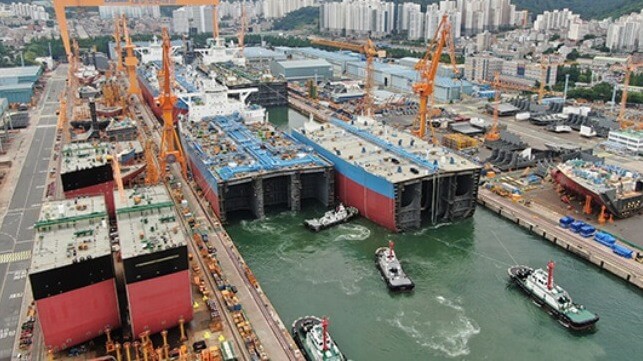Korean Shipbuilding Orders Reach 12-Year High Adding to Country’s Exports

Shipbuilding continues to be a significant part of the South Korean economy with the country’s Ministry of Trade highlighting this week its growing contribution to the country’s exports. While the overall shipbuilding industry has been retreating from the record order levels of the past two years, South Korea’s shipbuilders are expecting to maintain gradual improvements and highlight they currently have their largest backlog in 12 years.
The South Korean government vowed to support the industry by recently assisting with an increased number of visas for foreign workers and training programs while encouraging shipbuilders to focus on higher-priced vessels and the eco-friendly segments of the market. The ministry highlighted their success reporting that the strategy helped to drive strong results in the first half of 2023.
New orders won by South Korean shipbuilders increased nearly 12 percent in the first six months of 2023. The orders are being valued at $9.29 billion with the ministry noting that during the first half of last year, while the shipbuilding industry remained strong, the country’s industry booked orders worth $8.24 billion.
South Korea accounted for nearly a third (29 percent) of all the orders placed in the first half of 2023. More importantly, they highlighted that the country’s shipbuilders won 61 percent of the world’s orders for higher-priced vessels. According to data from Clarkson, they noted that the price index rose to $170.9 million, its highest level since $178 million in 2008, and even more importantly, the price of LNG carriers reached a new record of $260 million. South Korea continues to dominate that segment winning 87 percent of the orders for gas carriers placed so far in 2023.
All of this has helped South Korea to build its largest orderbook (38.8 million compensated gross tons according to Clarkson) since 2011. Twelve years ago, South Korea had orders of 39.88 million CGT. The current total equates to four years of work for the shipbuilders.
Recognizing the growing competition for lower-priced ships from China, South Korea began to increase its focus on the eco-friendly segments, which they define to include LNG and LPG carriers, as well as methanol and ethanol-fueled ships and the emerging market for batteries. At the same time, South Korea is looking to emerging alternative fuel systems, automation, and technology for autonomous shipping to provide its further leadership position.
Building the orders for the costlier new ships has helped South Korea to offset the declines in overall order volumes and improve profitability for the industry despite rising costs and labor shortages. As they continue to deliver the LNG carriers and more costly new ships, shipbuilding played an important role in South Korea’s overall $9.22 billion in exports in the first half of 2023, which were up 11.9 percent year over year.
The industry looks for further recoveries in the second half of 2023 noting that it has made strong progress on the order targets for the full year. They also continued the trends booking 59 percent of the total orders for value-added newbuilds and 51 percent of the orders for eco-friendly ships during July.
